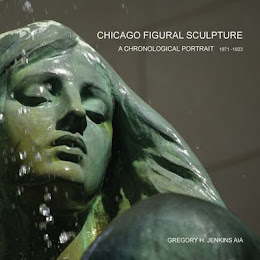TRANSITIONS
Hermon
Atkins MacNeil died at his Long Island Studio on October 2, 1947. Unable to transition from his Beaux Arts
training to a more "modern" style, he had not had a major commission
for nearly 15 years. When he died, the
contents of the studio was "hauled out to the dump" (where, much of
the collection was salvaged by neighbor, illustrator John A. Coughlin who later
donated it to the Smithsonian Institution.)
It hadn't always been that way.

In 1891, 25
year old MacNeil came West. To Chicago. Where he assisted Philip Martiny with sculpture at the Electricity Building at the World's Columbian
Exposition. And, where, on the Midway, he
met Black Pipe, an Ogalla Sioux, performing at
Buffalo Bill's Wild West Show. Native
Americans and their culture became the inspiration for MacNeil's art for years to come. By late 1895 he was on his way to Monument Valley
with Hamlin Garland and C.F. Browne --
after working with Edward Kemeys at the Marquette
(and no doubt hearing stories of Kemeys Wyoming
adventures some 20 years earlier).
.
The travels
West were just the beginning. By 1896 he
had married Carol Brooks (one of Lorado Taft's "White Rabbits - and a sculptor in her own right") and
had taken up residence at the American
Academy in Rome.
He won the Prixe de Rome in 1899.
And entered the Ecole des Beaux Arts in 1900. By 1901 he and Carol (with their two
children) had returned to America
and established their studio on Long Island. With an entire career before them.
An entire career before them. National in scope.. Beaux Arts in inspiration. MacNeil returned to Chicago in 1909, briefly, for the Cook County Seal Commission.
But my favorite remains his work in 1895. In Chicago. Where inspiration, youth, opportunity, and a
beautiful, capable wife converged with the past and the future -- at the Marquette Building.






























































